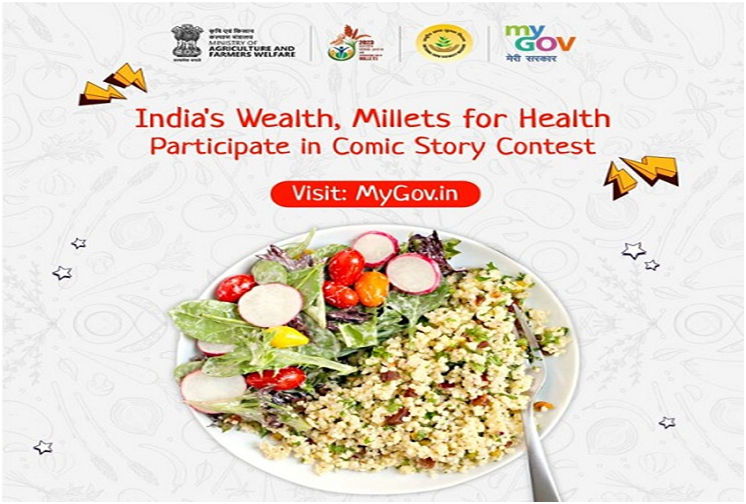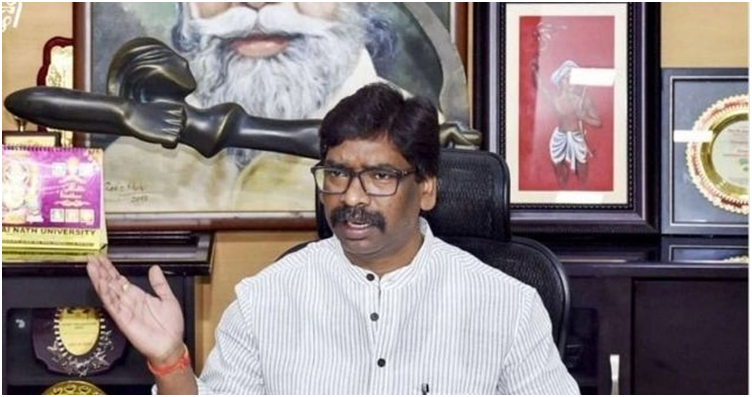Centre formulates action plan to promote exports of millets and value-added products of millets (GS Paper 3, Economy)

Why in news?
- To promote shipment of nutri-cereals, the Ministry of Commerce and Industry through its apex agricultural export promotion body, Agricultural and Processed Food Products Export Development Authority (APEDA) has prepared a comprehensive strategy to promote Indian millets exports across the globe commencing December 2022.
(Globalgreennews.com)
IYoM-2023:
Highlights of the strategy:
- For exports of Indian millets’ promotion, centre has planned to facilitate participation of exporters, farmers and traders in 16 international trade expos and Buyer Seller Meets (BSMs).
- As per the government’s robust strategy to promote millets, Indian missions abroad would be roped in branding and publicity of Indian millets, identification of international chefs as well as potential buyers such as departmental stores, supermarkets and hypermarkets for organizing B2B meetings and direct tie-ups.
- In addition, Ambassadors of Foreign missions in India of the targeted countries and potential importers would also be invited to showcase various millet-based products, including Ready to Eat millet products and facilitate B2B meetings.
- Government is also mobilizing start-ups for export promotion of value-added products in the Ready to Eat (RTE) and Ready to Serve (RTS) category such as noodles, pasta, breakfast cereals mix, biscuits, cookies, snacks, sweets, etc.
India in millet production:
Five-year strategic plan:
Millet exports:
- As per the DGCIS data, India registered a growth of 8.02% in the export of millets in the financial year 2021-22 as the export of millets was 159,332.16 metric tonne against 147,501.08 metric tonne during the same period last year.
- India’s major millet exporting countries are U.A.E, Nepal, Saudi Arabia, Libya, Oman, Egypt, Tunisia, Yemen, U.K and U.S.A.
- The varieties of millets exported by India include Bajra, Ragi, Canary, Jawar, and Buckwheat.
- The major millet importing countries in the world are Indonesia, Belgium, Japan, Germany, Mexico, Italy, the U.S.A, United Kingdom, Brazil and Netherlands.
Major varieties of millet:
- There are 16 major varieties of millet, which are produced and exported, including Sorghum (Jowar), Pearl Millet (Bajra), Finger Millet (Ragi) Minor Millets (Kangani), Proso Millet (Cheena), Kodo Millet (Kodo), Barnyard Millet (Sawa/Sanwa/Jhangora), Little Millet (Kutki), Two Pseudo Millets (BuckWheat/Kuttu), Ameranthus (Chaulai) and Brown Top Millet.
Jharkhand Cabinet approves four ambitious schemes for students and youths
(GS Paper 2, Governance)
Why in news?
- Higher and Technical Education department's Mukhya Mantri Shiksha Prothsahan Yojana (MMSPY),
- EklavyaPrasikshan Yojana (EPY) and
- Guruji Student Credit Card Yojana (GSCCY), and
- Labour department's Mukhya Mantri Sarathi Yojana (MMSY).
Mukhya Mantri Shiksha Prothsahan Yojana (MMSPY):
- Under the MMSPY, class 10 pass students will be provided free coaching at Jharkhand-based institutions of national repute for entrance examinations of engineering, medical, common law admission test, mass communication, fashion designing, hotel management and chartered accounting.
- Along with free coaching, a provision of Rs 2,500 scholarship per month has also been decided for lodging and other expenses of student.
- The only eligibility condition to qualify for the scheme is that student's parents should not come under the income tax criteria.
- The department targets to provide the benefit of the scheme to 8,000 students in a year.
EklavyaPrasikshan Yojana (EPY):
- Under EPY, job-oriented free coaching will be provided for various competitive examinations such as Union Public Service Commission, Jharkhand Public Service Commission, Bank PO, Bank Clerk, Railways and Staff Selection Commission.
- The department has set a target to provide coaching to 2,700 students in a year.

(NationalHeraldIndia.com)
Guruji Student Credit Card Yojana (GSCCY):
- The third scheme GSCCY is aimed at providing financial help to students, who would be selected for higher education, engineering, medical and others.
- Such students will be given a credit card, which has a maximum limit of Rs 15 lakh. Students can spend 30 per cent of Rs 15 lakh for non-institutional expenses such as lodging, food, books, laptops, etc.
- This 30 per cent component will go to the student, while the rest of the amount will go to institution as fees.
- Students will get this credit at an interest rate of 4 per cent and they will get 15 years’ time to repay the loan.
Mukhya Mantri Sarathi Yojana (MMSY):
- The Labour department's MMSY is part of Jharkhand Skill Mission. This scheme will take the skill mission to block level.
- The skill training programmes are mostly restricted to district headquarters. The skilling programme will be taken to block level with the help of the new scheme.
- Government has now allowed to use abandoned buildings or schools in the off-time. The youths will be trained in various skilling programmes such as tailoring, sewing and carpentering.
- The non-residential trainees will also be provided with an allowance Rs 1000.
Russias withdrawal from Kherson
(GS Paper 2, International Relation)
Why in news?
- Ukraine’s defence and intelligence unit has reported on the withdrawal of Russian troops from Kherson but predicts it to be a delusion for a retreat.
- U.S. President and the EU leaders have termed the withdrawal as a “difficult position” for Russian President and condemned the brutality of deporting Ukrainians.
Where is Kherson and why is it important?
How did Kherson come under Russia’s control?
- In early March 2022, Kherson was captured by Russia through intense fighting. The battle of Kherson proved to be the starting point to capturing and occupying the southern part of Ukraine while the battles for Kharkiv and Kyiv in the north progressed.
- Russia’s hold over Kherson since March 2022 enabled it to capture the key port cities; Mariupol in the Sea Azov, and Odesa, thus expanding control.
- Kherson’s irrigation canals were used as defence positions, creating a strong line preventing Ukraine’s counter-attacks. Russia also had positioned its soldiers in Kherson and stockpiled the ammunition.

(Forexlive.com)
Why has Russia announced its withdrawal from Kherson?
Mobilisation failure:
- When Russia was advancing rapidly in capturing the southern and northern cities of Ukraine, its military personnel and weapon systems started to run thin. Russia then pursued a partial mobilisation as the next strategy to circumvent its on-ground limitations.
- The failure of new recruits added an additional challenge to Russia to keep its hold against the Ukraine counter-offensive in Kherson.
Inability of Russia to govern Kherson:
- Despite imposing martial law, Russia could not effectively rule Kherson; the three-level security in the occupied areas could not enforce Russia’s control on the ground.
Ukraine’s expanding counter-offensive:
- Until August, Ukraine was supplied only with short-range and low-grade weapons by the West.
- Later, Ukrainian soldiers received military training; as Russia continued its onslaught, the West upgraded its support with medium to high-range weapons systems such as the Howitzers, HIMARS, air defence systems, battle tanks and drone technologies.
- It came from the U.S., the U.K. and Germany, whereas Russia’s procurement was slow and limited to Shahed drones.
- This helped Ukraine recapture Russian-occupied areas including Izyum, northeast, southeast of Kharkiv, Izyum-Slovyansk, Kupiansk in Eastern Ukraine, and northwest Kherson in the south. On the other hand, Russia has been facing challenges in augmenting its military hardware on the battleground.
Is the withdrawal final, or a tactical move by Russia?
- Russia’s new mobilisation has failed to stop the advancing of Ukraine forces. The challenges to remobilise its defence systems and the shortage of weapons must have played a role in Russia’s withdrawal.
- With Ukraine strengthening its military capacity through support from the West, upgrading from land-based to air-based to heavy battle tanks, Russia is facing a challenge to hold its occupied territories in Ukraine.
- However, this is not the first time Russia is making a withdrawal, after an initial onslaught. The attack on Ukraine’s capital Kyiv was an initial strategy of Russia.
- Later, Russia shifted its strategy from capturing Kyiv to concentrating on eastern Ukraine. Similarly, Russia also withdrew from its strategy to capture Kharkiv. Controlling Donetsk and Luhansk have become a significant objective.
- Withdrawal from Kherson exposes a serious gap in Russia’s strategy to hold southern Ukraine. However, it also underlines its strategy to withdraw under serious attack or resistance by the Ukrainian forces as it happened in Kyiv and Kharkiv.




